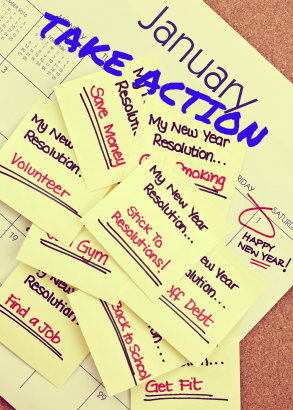It’s that time of year again with the sparkle of a new year comes the excitement of dreams to be fulfilled and the unknown yet to be discovered. We have come to one of life’s great punctuation marks full of bright potential and it’s “out with the old, in with the new” – a time to re-invent yourself. New Year is also that time when millions of people make resolutions, many of which will fizzle out as quickly as the fireworks.

Happy New Year
Are you wondering how you are still in a job you don’t like, life is out of balance and your clothes don’t fit? What happened to last year’s resolutions?
Statistics have shown us year after year that only a very small percentage of declarations survive beyond the January 1st hangover let alone get celebrated by the end of 12 months.
About 50% of Australians and 45% of Americans make NY resolutions and according to British psychologist Richard Wiseman 88% of all resolutions end in failure. That means there are literally millions of resolutions made and broken every year.
What stops me from moving from resolutions to goals?
The answer is simple. There is a significant difference between a NY resolution and a well-organized and compelling goal.
Imagine this: You have had five glasses of champagne, eaten very little as you have been busy socializing and its minutes to go to countdown. AND then voila! The fireworks go off and you shout your New Year’s Resolutions from the rooftop.
“This year I am going to get fit.” “This year I’m quitting smoking.” “This year I’m going to save money.”
 Most NY resolutions are about a habit, a behavior that you want to change i.e. wanting to kick or quit a habit like smoking or sugar, wanting to lose weight or get fit.
Most NY resolutions are about a habit, a behavior that you want to change i.e. wanting to kick or quit a habit like smoking or sugar, wanting to lose weight or get fit.
The trouble is that most resolutions are vague statements that are not linked to a goal that focuses on how specifically you can change the habit/behaviour.
This becomes challenging for your brain to focus and for you to have willpower and commitment and follow through with your resolutions.
Here’s an example using weight reduction as the goal to demonstrate how you can more effectively transform a resolution into a goal.
You may choose to “reduce” weight slowly and surely, perhaps an average of 1-2 kilos or 2lbs per week (or month) until you reach your ideal weight.
You will get a better result when you include a specific date and link your goal to a behaviour.
- “I have “reduced” 5kilos/10lbs on or before 30th April, 2016 through daily exercise for 20 minutes or more and reducing my portion sizes with every meal.
The behaviour in this example is “daily exercise for 20 minutes” and “reducing my portion sizes with every meal.”
What steps and action can I take to transform my NY resolutions into irresistible and achievable goals?
Think about the mindset you have around midnight and the hours to follow on NYE. Are you focused and clear headed with the willpower to succeed? Are you thinking about your values; what’s important to you and can you determine the resources you need to achieve your goals.
1. Go for a “Value-able” Life – a life of value
- Re-connect with your values. Ask yourself, “What is most important to me, what do I really value most?” Values are generally states of being i.e. happiness; we feel happy or for the value of health; we feel healthy.
- Write down your values.
- Create outcomes that match your values otherwise you may not achieve your goals or not be happy with them when you achieve them.
- If you value health you may decide to create a goal to “eat in a healthier way.” You need to link a behavior to the goal and qualify and quantify the behavior.
- I increase my organic food intake by 25% at every meal.
- I chew every mouthful at least 20 times to improve my digestion
2. Mindset
Do you have the mindset to enhance your ability to create an environment in which your goals can flourish?
Review the five most significant goals you achieved in 2016, and identify what specifically enhanced their achievement. Did you have a more consistently positive and optimistic mindset, commitment, willpower and enthusiasm? Was it the resources you had?
- You will have reference points for your goal achievement and success and you can model that success for 2016 and beyond
- Success does leave clues so pick up the clues from last year and apply your success strategies to your New Year’s goals.
- Maintain an “I can attitude”
3. Make sure you have the “write” intention to achieve your goals.
Writing your goals down creates a greater sense of connection and commitment to the outcome.
Writing your goals down also gives you a map of where you are going and allows you to keep track of your progress with specific outcomes and their time frames.
- Get a dedicated notebook to write your goals in.
- Ask yourself, what goal/s do I want to achieve? For each goal ask “Is this goal in alignment with my values?”
- Once you get the OK on alignment with your values write your goal down
- Allow uninterrupted time to be with our thoughts and focus.
4. Designing your Goals
You’ve decided what you want. Now it’s time to get very specific and envisage your goal or goals.
How do you represent your outcomes?
- Make your outcomes attractive and compelling so that you will want to move towards them.
- Be specific and make each goal measurable, realistic and achievable and time specific.
When it comes to time specific, I recommend to my clients that they start with “On or before” (see below) as that allows for the possibility of your goals to come to fruition before your conscious mind believes it possible.
- On or before 31st March 2016 I have increased my monthly savings by $50 or more. I will only have coffee in a café three times a week rather than seven days a week so I can save more than and extra $50/month.
Ask yourself these important questions
- Who will be with me when I achieve this goal?
- What will I be doing when I achieve this goal?
- Where will I be when I achieve this goal?
- When specifically will I achieve this goal?
And the most significant question to ask:
- What specifically do I want through having this goal in my life?
These questions will trigger your brain to make a representation of how your specific goal will be when you have achieved it and also align you with the purpose or intention of your goal.
5. Resources
Identify the resources that you have now – health, mindset, family, time, money, skills, technology and friends. Think about any resources you need to achieve your goal/s i.e.
- Do I need to learn any new skills, update technology or build relationships to enhance the achievement of my outcomes?
- Do I need professional help and support from a Personal Trainer or Business/Life Coach?
Do you think it is possible to achieve an outcome without resources? Asking these questions can help you to identify any of the resources that you may need to achieve your outcomes.
Follow these 5 practical and powerful steps and you will be well on your way to a being a goal getter in 2016 and beyond.
Have a Blissful 2016 and happy Goal Getting.
Over to you to share your goal getting comments below…

Leave a Reply